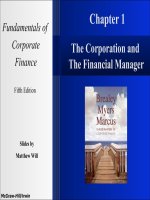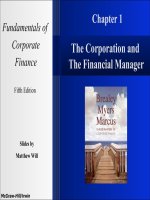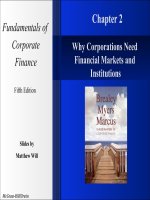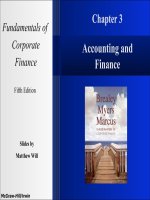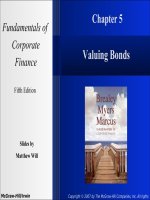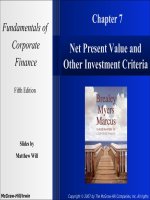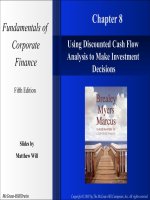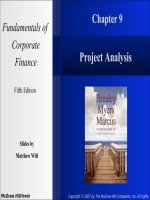Fundamentals of corporate finance 10e ROSS JORDAN chap013
Bạn đang xem bản rút gọn của tài liệu. Xem và tải ngay bản đầy đủ của tài liệu tại đây (1.67 MB, 77 trang )
Chapter
13
Return, Risk, and the Security
Market Line
13-1
McGraw-Hill/Irwin
Copyright © 2013 by The McGraw-Hill Companies, Inc. All rights reserved.
Chapter Outline
• Expected Returns and Variances
• Portfolios
• Announcements, Surprises, and Expected Returns
• Risk: Systematic and Unsystematic
• Diversification and Portfolio Risk
• Systematic Risk and Beta
• The Security Market Line
• The SML and the Cost of Capital: A Preview
13-2
Chapter Outline
• Expected Returns and Variances
• Portfolios
• Announcements, Surprises, and Expected Returns
• Risk: Systematic and Unsystematic
• Diversification and Portfolio Risk
• Systematic Risk and Beta
• The Security Market Line
• The SML and the Cost of Capital: A Preview
13-3
Expected Returns
• Expected returns are based on the probabilities
of possible outcomes
• In this context, “expected” means average if
the process is repeated many times
• The “expected” return does not even have to be
a possible return
n
E ( R ) = ∑ pi Ri
i =1
13-4
Example: Expected
Returns
Suppose you have predicted the following returns
for stocks C and T in three possible states of the
economy.
1. What is the probability of “Recession”?
State Probability C T
Boom
0.3
15 25
Normal 0.5
10 20
Recession ???
2 1
13-5
Probabilities add up to 100% (or 1.0) thus 1.0 – 0.3
– 0.5 =0.2 or 20%
Example: Expected
Returns
Suppose you have predicted the following returns
for stocks C and T in three possible states of the
economy.
2. What are the expected returns?
State Probability C T
Boom
0.3
15 25
Normal 0.5
10 20
Recession 0.2
2 1
RC =.3(15) +.5(10) +.2(2) =9.9%
RT =.3(25) +.5(20) +.2(1) =17.7%
13-6
Example: Expected
Returns
The three states of the economy still apply to
stocks C and T.
3. If the risk-free rate (from chapter 12) is 4.15%,
what is the risk premium for C & T?
RC =.3(15) +.5(10) +.2(2) =9.9%
RT =.3(25) +.5(20) +.2(1) =17.7%
Stock C’s risk premium: 9.9 - 4.15 =5.75%
Stock T’s risk premium: 17.7 - 4.15 =13.55%
13-7
Variance and Standard
Deviation
• Variance and standard deviation
measure the volatility of returns
• Using unequal probabilities for the
entire range of possible outcomes
• Weighted average of squared deviations
n
σ = ∑ pi ( Ri − E ( R))
2
13-8
i =1
2
Example: Variance and
Standard Deviation
Considering the previous example of
stocks C and T:
State Probability C T
Boom
0.3
15 25
Normal 0.5
10 20
Recession 0.2
2 1
Expected return
9.9%
13-9
17.7%
Example: Variance and
Standard Deviation
1. What is the variance and standard
deviation for C?
13-10
State Probability C T
Boom
0.3
15 25
Normal 0.5
10 20
Recession 0.2
2 1
Expected return
9.9% 17.7%
Stock C
σ2 = .3(15-9.9)2 + .5(10-9.9)2 + .2(2-9.9)2
= 20.29
σ = 4.50%
Example: Variance and
Standard Deviation
2. What is the variance and standard
deviation for T?
13-11
State Probability C T
Boom
0.3
15 25
Normal 0.5
10 20
Recession 0.2
2 1
Expected return
9.9% 17.7%
Stock T
σ2 = .3(25-17.7)2 + .5(20-17.7)2 + .
2(1-17.7)2 = 74.41
σ = 8.63%
Another Example
Consider the following information:
State
Probability ABC, Inc. (%)
Boom .25
15
Normal
.50
8
Slowdown
.15
4
Recession
.10
-3
1. What is the expected return?
E(R) = .25(15) + .5(8) + .15(4) + .1(-3)
= 8.05%
13-12
Another Example
Consider the following information:
State
Probability ABC, Inc. (%)
Boom .25
15
Normal
.50
8
Slowdown
.15
4
Recession
.10
-3
2. What is the variance?
13-13
Variance = σ2= .25(15-8.05)2 + .5(8-8.05)2 + .
15(4-8.05)2 + .1(-3-8.05)2
= 26.7475
Another Example
Consider the following information:
State
Probability ABC, Inc. (%)
Boom .25
15
Normal
.50
8
Slowdown
.15
4
Recession
.10
-3
3. What is the standard deviation?
Standard Deviation = σ = √ 26.7475
= 5.17%
13-14
Chapter Outline
• Expected Returns and Variances
• Portfolios
• Announcements, Surprises, and Expected Returns
• Risk: Systematic and Unsystematic
• Diversification and Portfolio Risk
• Systematic Risk and Beta
• The Security Market Line
• The SML and the Cost of Capital: A Preview
13-15
Portfolios
• A portfolio is a
collection of assets
• An asset’s risk and
return are important in
how they affect the risk
and return of the
portfolio
13-16
Portfolios
•The risk/return tradeoff for a portfolio is
measured by the
portfolio’s expected
return and standard
deviation, just as with Risk
individual assets
13-17
Return
Example: Portfolio
Weights
Suppose you have $15,000 to
invest and you have purchased
securities in the following
amounts:
$2000 of DCLK
$3000 of KO
$4000 of INTC
$6000 of KEI
13-18
Example: Portfolio
Weights
What are your portfolio weights in
each security?
$2,000 of DCLK
$3,000 of KO
$4,000 of INTC
$6,000 of KEI
$15,000
13-19
DCLK: 2/15 = .133
KO: 3/15 = .200
INTC: 4/15 = .267
KEI: 6/15 = .400
15/15 = 1.000
Portfolio Expected
Returns
The expected return of a portfolio is the weighted
average of the expected returns of the respective
assets in the portfolio
m
E ( RP ) = ∑ w j E ( R j )
j =1
You can also find the expected return by finding
the portfolio return in each possible state and
computing the expected value as we did with
individual securities
13-20
Example: Expected
Portfolio Returns
Consider the portfolio weights computed
previously. The individual stocks have the
following expected returns:
DCLK: 19.69%
KO: 5.25%
INTC: 16.65%
KEI: 18.24%
13-21
Example: Expected
Portfolio Returns
1. What is the expected return on this
portfolio?
Return Weight
DCLK: 19.69% .133
KO: 5.25% .200
INTC: 16.65% .267
KEI: 18.24% .400
E(RP) = .133(19.69) + .2(5.25) + .267(16.65) + .4(18.24)
= 15.41%
13-22
Portfolio Variance
•Compute the expected portfolio return, the
variance, and the standard deviation using the
same formula as for an individual asset
•Compute the portfolio return for each state:
RP = w1R1 + w2R2 + … + wmRm
13-23
Example: Portfolio
Variance
Consider the following information:
State Probability A B
Boom .4
30% -5%
Bust .6
-10% 25%
13-24
Example: Portfolio
Variance
Consider the following information:
State Probability A B
Boom .4
30% -5%
Bust .6
-10% 25%
1. What is the expected return for
asset A?
Asset A: E(RA) = .4(30) + .6(-10) = 6%
13-25
